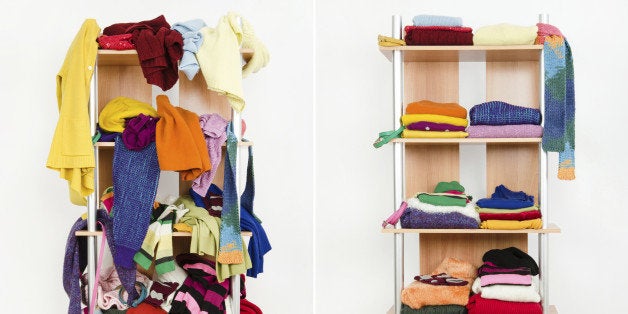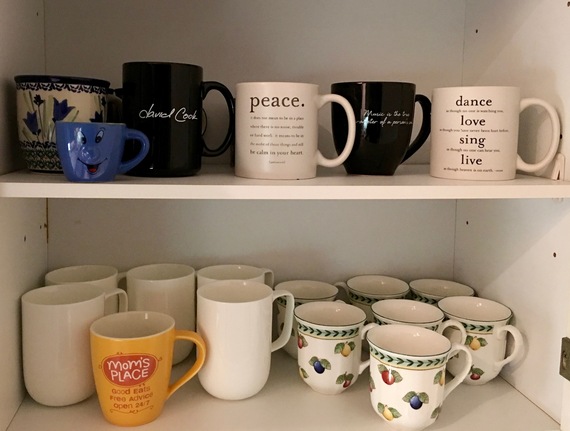
It started with the great mug rebellion.
Over the years, I'd accumulated so many of them.
I had mugs that were gifts; souvenir mugs bought on many different trips around the country; mugs with wise quotes on them; mugs with rock star photos or signatures; yeah, more than a multitude of mugs.
They lived in the corner cupboard of my kitchen, where, because of the shape and depth of it, I could see and use only the ones in the first two rows.
One morning, I came downstairs sleepy eyed and as I reached for a coffee mug, had an incredible urge to move them all to a new place.
They whispered to me in conspiratorial tones. They were tired of standing at attention in the dark recesses of a hard-to-reach cupboard.
Ultimately, their call was so persistent that I pulled them all out onto the counter even before having my coffee.
I couldn't understand this urge (yet), but I followed it, (A good lesson in itself.)
I packed up more than half the mugs to give away and found a new shelf for the ones I truly loved where they could all be seen and enjoyed.
I'd been talking for months about how I wanted to walk into my home, and light up with joy and peace.
Everything tidy and clean, everything belonging right where it was. This magical non-clutter would grant me the freedom to enjoy, create, relax, live, and do exactly what I wanted.
I also knew that the energy of that environment would influence my own. But it was all talk before the mugs got me started.
For the decluttering process that followed, I channeled Marie Kondo's advice in The Life Changing Magic of Tidying Up.
-Declutter in categories.
-Give each item your full attention.
This was difficult. There were happy memories, funny incidents that gave me giggling fits. But the process also brought out buried fears, hurts, and questions about old relationships, old patterns that didn't serve me any longer.
Sitting with that pain and facing the fears took time, but afterward I felt liberated and grateful for all the lessons learned from living and accumulating stuff.
As my house gave up the unnecessary items, I worked through and discarded old, no longer useful thoughts and beliefs.
I didn't think it would take very long because I'd never been a hoarder; I figured a week at most. But after over 40 years of marriage, two kids, and three homes, I'd accumulated... stuff.
Actually, it took me five whole months and a week to work through everything. And I came out the other side with greater self-knowledge and understanding.
How to use the decluttering process to help you know yourself:
1. Ask yourself questions. Lots and lots of questions. You might be surprised at the answers you get.
It's a good way to dig deeper and understand what your motivations for a particular decision are, how your conditioned mind might be keeping you stuck in unhelpful patterns. It brings awareness to your fears and beliefs about obligations and lack vs. abundance.
Here are a few I asked myself:
•Do you think you won't be able to afford to replace a rarely used gadget (should you decide to toss it), just in case you need it one day? Or it will have completely disappeared from the face of the planet?
•Do you believe you couldn't possibly live without it?
•Do you have emotional attachments to objects from the past, or memories from loved ones? Will the memories and love fade away if the objects aren't there?
•Do you feel guilty giving away gifts that have absolutely no use for you? What is the guilt about?
•Do you keep five sizes of clothing because you feel you might lose or gain weight and then you'll have nothing to wear? What is the fear about?
•Do you buy extra food because it's on sale and then end up throwing it away because it's expired?
2. "Stuff" can function as metaphors for what's going on in your personal life.
It has been said that every choice we make in the material world reflects the condition of our inner lives.
The words you use to describe what you like and dislike about your living space, what you decide to keep and what to discard are often powerful metaphors for your life.
Look at your living space and describe your most and least favorite areas. Don't overthink this. Use adjectives like dark, bright, peaceful, disturbing, confusing, small, cramped, etc. Then ask yourself where in your life you find similar descriptions at work.
For example, I realized my least favorite space in the house is the tiny, windowless laundry room. It feels like a small, dark cave even with the ceiling light.
So based on my description, I asked myself, "What needs to see more light in my life?
I noticed my creative impulses had been buried and hidden for far too long. They needed to see more light. I wanted to write, photograph nature, even garden and cook more creatively.
3. Imagine replacing items that don't bring you joy with those that would.
Once you identify areas or objects you don't love in your home, close your eyes and think of places and things you love. Describe how they make you feel. Maybe more open, daring, colorful than your normal way of being.
Replace unloved items you're discarding with some object that gives you the feelings you described above. Repeat until you love the space you hated before. Even one small change like this has a "butterfly effect" on the rest of your life experience.
For example, I live in an area where there's no body of water and I love the ocean. I hung a beautiful painting of the ocean in my living room. This made me feel good and remember my love for the waves, so I decided to visit the ocean as much as possible on my vacations. This is leading to planning for retirement near the ocean.
You can use the same process on many other things, like your calendar, career, and relationships.
Find a pattern in a part of your life you dislike and want to change. This could be anything, a way of communicating, scheduling dilemmas, people pleasing tendencies. Imagine and describe a more beautiful and coherent life you desire. Find something you can do or bring into your life that fits the description of your desired life. Bring that new pattern in and discard the old one.
A small change can lead you down a totally different path over time.
This brings me to the original urge to get those mugs out of the corner cabinet. There was a message for me in there.
4. Don't hide what matters to you.
What was this urge to move the mugs really telling me? Bring stuff out into the open, look at it, get rid of the unwanted, and keep what you do want where you can see it.
Hidden up high where I couldn't see or reach them, the mugs were a metaphor for everything hidden and unseen in my life. Thoughts, beliefs, habits, relationships, shadow elements, and fears -- they all need to be looked at on a regular basis.
The Great Mug Rebellion wasn't without some casualties. Only a few made it into the new cupboard shelf (one that was lower and easier for me to reach). And I'm much more aware now of my need to re-examine habits, relationships and beliefs and question their value in my life.
Ultimately, I learned to listen to my inner voice; to enjoy my belongings, love them and use them now. I learned a way to look deeper into what makes me happy and how to go about creating a life I love one step at a time. I learned to surround myself with the objects, people, and thoughts that create more love.
Clear space. Clear Mind. Clear Heart.

